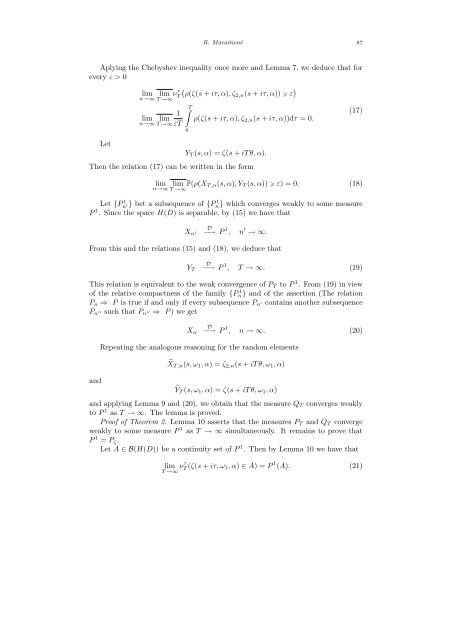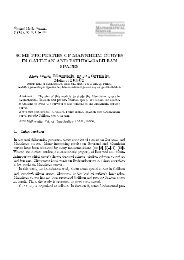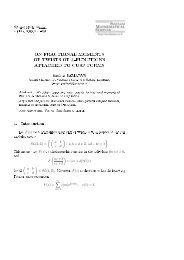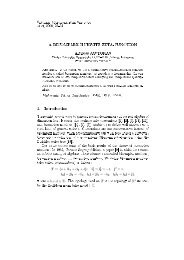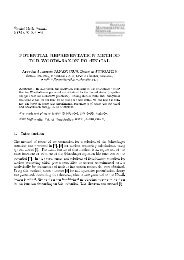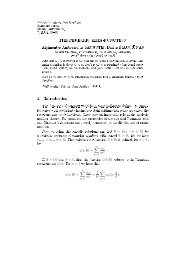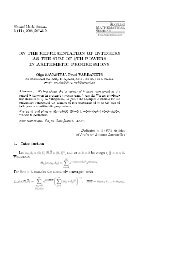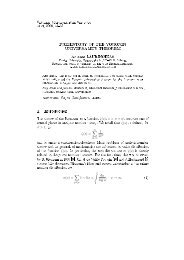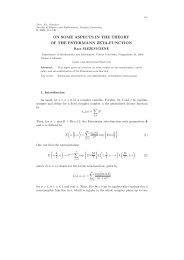a limit theorem for the hurwitz zeta-function in the space of analytic ...
a limit theorem for the hurwitz zeta-function in the space of analytic ...
a limit theorem for the hurwitz zeta-function in the space of analytic ...
Create successful ePaper yourself
Turn your PDF publications into a flip-book with our unique Google optimized e-Paper software.
R. Macaitienė 87<br />
Aply<strong>in</strong>g <strong>the</strong> Chebyshev <strong>in</strong>equality once more and Lemma 7, we deduce that <strong>for</strong><br />
every ε > 0<br />
lim lim<br />
(<br />
ρ(ζ(s + iτ, α), ζ2,n (s + iτ, α)) ε )<br />
Let<br />
n→∞ T →∞ ντ T<br />
∫ T<br />
lim<br />
lim<br />
n→∞ T →∞<br />
1<br />
εT<br />
0<br />
ρ(ζ(s + iτ, α), ζ 2,n (s + iτ, α))dτ = 0.<br />
Y T (s, α) = ζ(s + iT θ, α).<br />
Then <strong>the</strong> relation (17) can be written <strong>in</strong> <strong>the</strong> <strong>for</strong>m<br />
lim<br />
n→∞<br />
(17)<br />
lim P(ρ(X T,n(s, α), Y T (s, α)) ε) = 0. (18)<br />
T →∞<br />
Let {P 1 n ′} bet a subsequence <strong>of</strong> {P 1 n} which converges weakly to some measure<br />
P 1 . S<strong>in</strong>ce <strong>the</strong> <strong>space</strong> H(D) is separable, by (15) we have that<br />
X n ′<br />
D<br />
−→ P 1 , n ′ → ∞.<br />
From this and <strong>the</strong> relations (15) and (18), we deduce that<br />
Y T<br />
D<br />
−→ P 1 , T → ∞. (19)<br />
This relation is equivalent to <strong>the</strong> weak convergence <strong>of</strong> P T to P 1 . From (19) <strong>in</strong> view<br />
<strong>of</strong> <strong>the</strong> relative compactness <strong>of</strong> <strong>the</strong> family {Pn} 1 and <strong>of</strong> <strong>the</strong> assertion (The relation<br />
P n ⇒ P is true if and only if every subsequence P n ′ conta<strong>in</strong>s ano<strong>the</strong>r subsequence<br />
P n ′′ such that P n ′′ ⇒ P ) we get<br />
X n<br />
D<br />
−→ P 1 , n → ∞. (20)<br />
and<br />
Repeat<strong>in</strong>g <strong>the</strong> analogous reason<strong>in</strong>g <strong>for</strong> <strong>the</strong> random elements<br />
˜X T,n (s, ω 1 , α) = ζ 2,n (s + iT θ, ω 1 , α)<br />
Ỹ T (s, ω 1 , α) = ζ(s + iT θ, ω 1 , α)<br />
and apply<strong>in</strong>g Lemma 9 and (20), we obta<strong>in</strong> that <strong>the</strong> measure Q T converges weakly<br />
to P 1 as T → ∞. The lemma is proved.<br />
Pro<strong>of</strong> <strong>of</strong> Theorem 2. Lemma 10 asserts that <strong>the</strong> measures P T and Q T converge<br />
weakly to some measure P 1 as T → ∞ simultaneously. It rema<strong>in</strong>s to prove that<br />
P 1 = P ζ .<br />
Let A ∈ B(H(D)) be a cont<strong>in</strong>uity set <strong>of</strong> P 1 . Then by Lemma 10 we have that<br />
lim<br />
T →∞ ντ T (ζ(s + iτ, ω 1 , α) ∈ A) = P 1 (A). (21)


